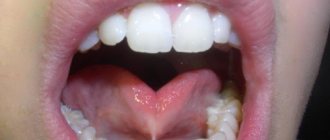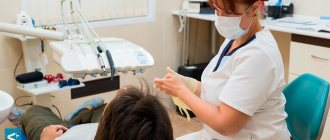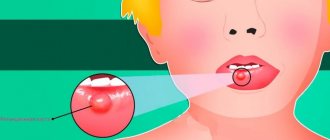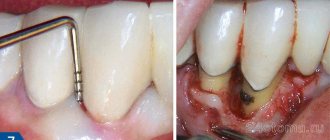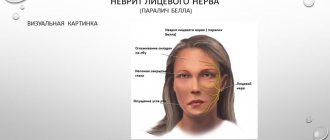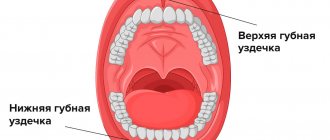Tongue frenulum cutting - what is it?
Plastic surgery of the lingual frenulum can be performed at different ages, but it is mainly performed on newborn children, since disruption of the formation of the mucosal fold under the tongue causes a number of functional disorders.
The procedure for trimming the frenulum of the tongue is a low-traumatic surgical procedure performed by a dentist. The frenulum of the tongue is a fold of the oral mucosa that stretches in the shape of an arc from the central point of the tongue to the middle of the lower dentition at the base of the gums. The main function of the frenulum is to attach the tongue to the lower part of the mouth.
If there are deviations in the location or length of the fold, the movement of the tongue will be impaired, resulting in incomplete functionality. The purpose of the operation is to increase the length or correct the position of the frenulum.
Indications for the procedure
For newborn children, cutting the frenulum of the tongue is recommended quite often. A pediatrician or dentist can identify the pathology. In most cases, disorders are detected already in the first months of a child’s life. At the same time, the doctor always takes into account the individual characteristics of the structure and position of the mucous fold.
If we are talking about a newborn baby, then plastic surgery is prescribed in the case of obvious pathology in the formation of the frenulum, or difficulties with breastfeeding. The baby may have difficulty latching on to the nipple or pacifier and difficulty sucking on the breast or bottle.
Untimely plastic surgery may subsequently lead to difficulties with chewing food, bite formation, and diction problems. In older age, recommendations for surgical treatment can be given by a speech therapist or orthodontist.
Contraindications
Tongue frenuloplasty in newborns does not involve major surgical intervention, so the operation is considered safe. In addition, the procedure is painless and does not require anesthesia. However, given that after cutting a short fold of mucosa, a small wound still forms, there are temporary restrictions on manipulation related to the child’s health condition.
Temporary contraindications:
- inflammatory diseases;
- infectious diseases;
- immunodeficiency pathologies;
- acute respiratory viral or bacterial infections.
If there are contraindications for health reasons, it is advisable to postpone the operation until complete recovery.
Features of the procedure
Plastic surgery of the frenulum of the tongue involves cutting it with a scalpel or surgical scissors. After cutting the fold of the mucous membrane in a newborn, the tissue immediately stretches and lengthens after healing. When the operation is performed at the age of 3–5 years, the process of stretching the frenulum is more complex. To increase the length of the fold and prevent the formation of scars, the child will need to perform special exercises.
In Martinka dentistry, plastic surgery of the frenulum of the tongue and lip is performed not only by the classical, but also by the modern method using a laser. The use of laser equipment eliminates the risk of infection and bleeding. The laser has an antiseptic effect and instantly seals the vessels; moreover, during the operation there is no contact of the instrument with the tissues of the oral cavity. Laser surgery involves contraindications and is only allowed for children over 1 year of age.
For newborn children, tongue frenuloplasty can be performed without anesthesia. In children from 3 months of age, the folds of the mucous membrane thicken, which suggests discomfort and minor pain during the operation, so cutting the frenulum is done with local anesthesia. Sedation is used only in extreme cases, if the child has complex illnesses or increased anxiety.
Implantation: rules of care after surgery
Dental implantation is another type of surgical intervention, after which careful care of teeth and gums is required. Even if the most modern medical equipment was used during the operation and the implants consist of the latest materials, the patient needs to know a number of standard recommendations.
Care immediately after dental implantation
After the operation, begin applying ice to the cheek on which the intervention took place. This can be done several times with a break of twenty minutes. It is enough to hold the ice on your cheek for seven to ten minutes.
After the dental implantation procedure, you can wipe the wounded area with a cotton swab soaked in water and salt. You can add just a little iodine to the water. If you are bleeding heavily, apply a sterile gauze pad to the wound for twenty minutes. Remember that bleeding after implantation, as well as after tooth extraction, is normal if it does not last too long.
If you experience pain, you can use painkillers prescribed by your doctor, but not earlier than an hour and a half after the operation.
Care for several days after implantation
When you brush your teeth, in the first few days try not to touch the sore spot with the bristles. To treat the implant, use water with a little salt dissolved in it. In food, exclude the consumption of hard fruits, tea, coffee, carbonated sweet and mineral waters, alcoholic beverages, and hot food. This ban lasts two to three days, the ban on eating hot food lasts for a day.
Stages of the procedure
Trimming a short frenulum, despite the lack of complexity of the procedure, should be performed by a qualified specialist and in a medical facility. Patients do not require hospitalization. The operation takes no more than 10 minutes. Immediately after completion of the plastic surgery, the child is sent home. It is not recommended to feed the baby in the first two hours. Young children are allowed to drink water.
Stages of plastic surgery of the frenulum of the tongue.
- Preparation. The doctor asks parents for complaints, performs an examination and, if necessary, gives recommendations on preparation for the procedure.
- Operation. Administration of anesthesia, antiseptic treatment of the oral cavity, trimming of the frenulum.
In newborns, the integrity of the mucous membrane is restored in 1–3 days. The child may be restless on the first day. Difficulties with feeding cannot be ruled out, but already on the second day, babies begin to correctly take the breast or bottle nipple, which caused difficulties previously. Parents are advised to give the baby water after each feeding to avoid the accumulation of formula or milk in the mouth and the subsequent development of infection. Also, the mother must maintain breast hygiene and sterilize bottles.
What care is required after tooth extraction
Tooth extraction may be indicated for various reasons. The main ones are excessive tooth decay due to caries and other oral diseases or tooth deformation after injury.
Basic rules after surgery
If you have had a tooth removed, special monitoring of your oral cavity is required in the first days after surgery. For the first few hours (usually the dentist determines the exact amount), it is not advisable to eat food or drink water. Avoid brushing the area where the tooth was removed with a toothbrush the first time you brush your teeth after surgery. For oral hygiene, use a brush with soft bristles. Do not use mouthwash. Follow this rule for two days.
When eating food over the next two days, exclude from your diet hard fruits, too hot or cold foods, as well as tea, coffee, alcohol and carbonated drinks. Smokers will have to give up their addiction, if not completely, then at least for two days after tooth extraction.
It often happens that after tooth extraction, the patient experiences swelling of the gums and swelling. There is no need to worry - this is a normal reaction of the gums after surgery. To reduce discomfort, place something fairly cold under your cheek on the side where the tooth was removed. Regular ice will do for this. Hold it on the sore spot for ten minutes, rest for twenty minutes and hold it again for ten minutes. The swelling will go down and will no longer bother you.
Increased physical activity is not recommended during the postoperative period. The fact is that active sports, lifting weights and strength exercises can cause bleeding at the extraction site. When you go to bed, place two pillows under your head at once - you need to keep your head elevated while sleeping.
Taking medications and the healing process
If you feel pain within a few days after tooth extraction, you can take painkillers, but only after the consent of the attending dentist. Analgesics are best for pain relief. If you, on the advice of your doctor, used antibiotics before surgery, then most likely your dentist will recommend that you stop using them gradually. You should not completely stop taking them right on the day of surgery; this can cause a decrease in the body's resistance and rapid proliferation of bacteria.
Finally, remember two particularly important recommendations to follow after surgery. If blood flows from the wound after tooth extraction, then place a tampon on this place, bite firmly and hold for forty-five minutes. Bleeding in itself is not a sign that something is wrong; it is a natural phenomenon, but it can cause a number of inconveniences. The only thing that should alert you is if the bleeding does not stop even after two procedures. Then contact your doctor immediately.
A blood clot should very quickly form in the empty socket at the site of the extracted tooth. It has a positive effect on the healing of the area. Be careful not to touch the clot. Not only is proper oral hygiene, which is described above, important, but it is also undesirable to spit so as not to injure the clot.
results
The main goal of tongue frenuloplasty is to prevent tongue dysfunction that occurs subsequently. If you do not trim the folds of mucous membrane, then in the future the child may have difficulties with eating, diction and lip movements.
Don't be afraid of surgery. This is a simple procedure that takes a few minutes, and the cutting of the short frenulum itself takes place in a few seconds. Since the mucous membrane in children is still too thin, the child does not feel pain. Minor bleeding goes away quickly and does not pose any danger.
The help of a qualified dentist is an absolute guarantee of high-quality results and the absence of complications.
Possible complications
Almost always such an operation takes place without any complications. This is due to its lightness, as well as the simplicity of the structure of the bridle itself. The only possible option when complications appear is the postoperative period.
At this time, if the rehabilitation regime and doctor’s instructions are not followed, small, rather painful inflammatory processes may form in the damaged areas
. Therefore, it is necessary to strictly follow all instructions regarding hygiene, diet, and so on.
Another possible complication is that very rarely, in older children (teenagers), a visible and hard scar may form.
. This necessitates repeated plastic surgery to remove it.
Sources
- https://tvoidantist.ru/lechenie/detskaya-stomatologiya/podrezanie-uzdechki-pod-yazykom.html
- https://MikDent.ru/rebenok/yazyk/podrezanie-uzdechki-pod-yazykom-u-detej.html
- https://VseProRebenka.ru/zdorove/procedury/plastika-uzdechki-yazyka.html
- https://DentConsult.ru/polost-rta/podrezanie-uzdechki-yazyka-i-gub.html
- https://dentist-pro.ru/detskaya-stomatologiya/yazyk/podrezanie-uzdechki.html
- https://www.vash-dentist.ru/detskaya-stomatologia/yazyik/operatsiya-podrezaniya-uzdechki.html
- https://prozubi24.ru/podrezanie-uzdechki-pod-jazykom-u-detej/
- https://dentalzub.com/podrezanie-uzdechki-pod-yazyikom-u-detey
